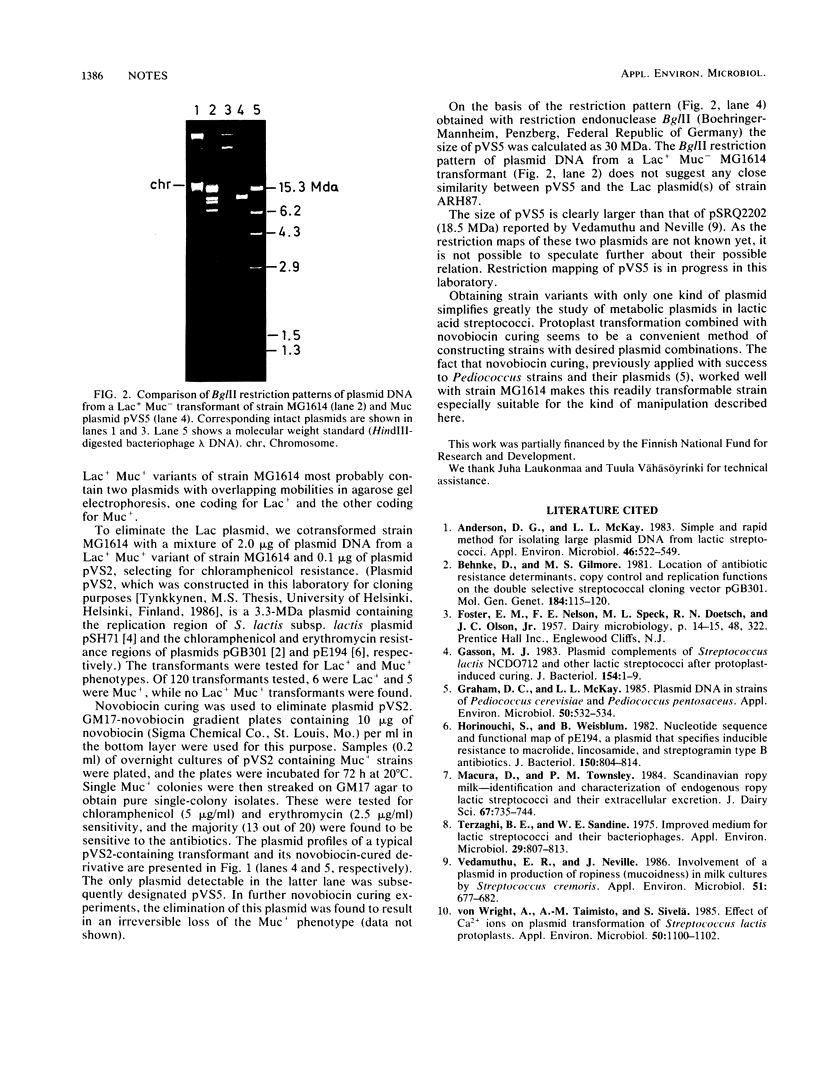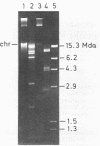Abstract
Lactose-fermenting mucoid (Lac+ Muc+) variants of plasmid-free Streptococcus lactis subsp. lactis MG1614 were obtained by protoplast transformation with total plasmid DNA from Muc+S. lactis subsp. cremoris ARH87. By using plasmid DNA from these variants for further transformations followed by novobiocininduced plasmid curing, Lac− Muc+ MG1614 strains containing only a single 30-megadalton plasmid could be constructed. This plasmid, designated pVS5, appeared to be associated with the Muc+ phenotype.
Full text
PDF

Images in this article
Selected References
These references are in PubMed. This may not be the complete list of references from this article.
- Anderson D. G., McKay L. L. Simple and rapid method for isolating large plasmid DNA from lactic streptococci. Appl Environ Microbiol. 1983 Sep;46(3):549–552. doi: 10.1128/aem.46.3.549-552.1983. [DOI] [PMC free article] [PubMed] [Google Scholar]
- Behnke D., Gilmore M. S. Location of antibiotic resistance determinants, copy control, and replication functions on the double-selective streptococcal cloning vector pGB301. Mol Gen Genet. 1981;184(1):115–120. doi: 10.1007/BF00271206. [DOI] [PubMed] [Google Scholar]
- Gasson M. J. Plasmid complements of Streptococcus lactis NCDO 712 and other lactic streptococci after protoplast-induced curing. J Bacteriol. 1983 Apr;154(1):1–9. doi: 10.1128/jb.154.1.1-9.1983. [DOI] [PMC free article] [PubMed] [Google Scholar]
- Graham D. C., McKay L. L. Plasmid DNA in Strains of Pediococcus cerevisiae and Pediococcus pentosaceus. Appl Environ Microbiol. 1985 Aug;50(2):532–534. doi: 10.1128/aem.50.2.532-534.1985. [DOI] [PMC free article] [PubMed] [Google Scholar]
- Horinouchi S., Weisblum B. Nucleotide sequence and functional map of pE194, a plasmid that specifies inducible resistance to macrolide, lincosamide, and streptogramin type B antibodies. J Bacteriol. 1982 May;150(2):804–814. doi: 10.1128/jb.150.2.804-814.1982. [DOI] [PMC free article] [PubMed] [Google Scholar]
- Terzaghi B. E., Sandine W. E. Improved medium for lactic streptococci and their bacteriophages. Appl Microbiol. 1975 Jun;29(6):807–813. doi: 10.1128/am.29.6.807-813.1975. [DOI] [PMC free article] [PubMed] [Google Scholar]
- Vedamuthu E. R., Neville J. M. Involvement of a Plasmid in Production of Ropiness (Mucoidness) in Milk Cultures by Streptococcus cremoris MS. Appl Environ Microbiol. 1986 Apr;51(4):677–682. doi: 10.1128/aem.51.4.677-682.1986. [DOI] [PMC free article] [PubMed] [Google Scholar]
- von Wright A., Taimisto A. M., Sivelä S. Effect of Ca2+ ions on plasmid transformation of Streptococcus lactis protoplasts. Appl Environ Microbiol. 1985 Oct;50(4):1100–1102. doi: 10.1128/aem.50.4.1100-1102.1985. [DOI] [PMC free article] [PubMed] [Google Scholar]




